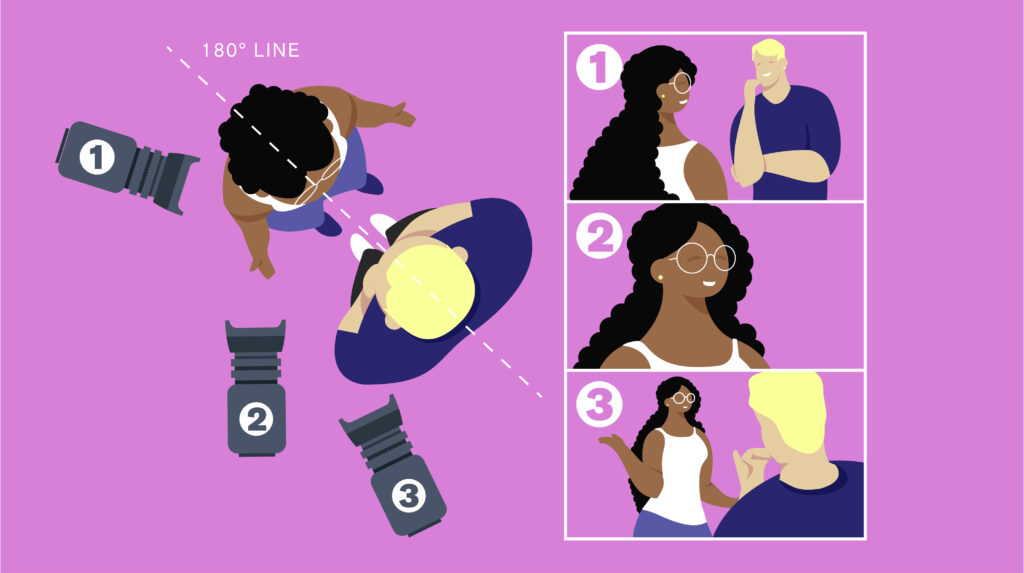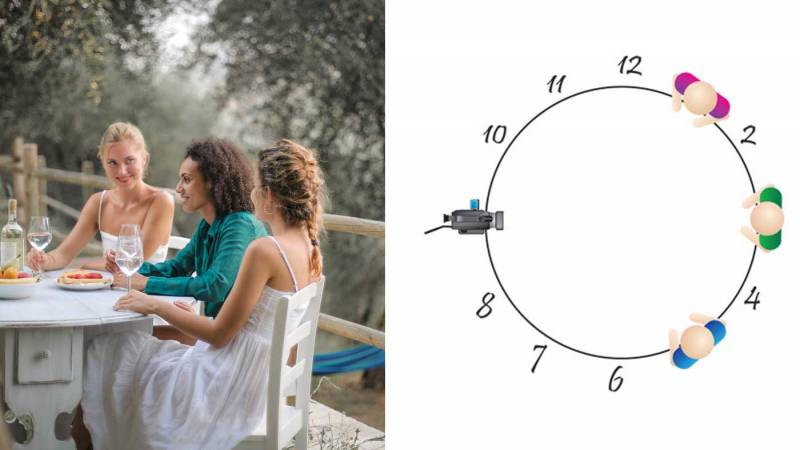Definition
Blocking refers to the physical relationships among characters, props, and the set. It is a term that is applicable to stage performance and filmmaking. Where might you place, or hide as the case may be, your camera if you are shooting a scene involving mirrors, for example? If you have more than one camera in operation, how do you avoid revealing the presence of other cameras?
All considerations that go into the placement of props and actors fall under the rubric of “blocking.” Here is a short video about blocking:
In other words, blocking involves rehearsed and scripted movements of actors and props. Blocking in film revolves around the camera, and camera movement (camerawork) is a central element of blocking.
The camera could function as an independent character, a visual guide, a narrator, a creepy stalker (if following a character around), or any combination of these roles. The camera could stay still as a detached observer, or it could be a zealous participant in the dramatic action.
Elements
Key to blocking is the 180-degree rule which ensures visual and narrative continuity by positioning strategically actors and cameras. One of the goals is the avoid revealing, in a shot, the presence of other cameras!

Source: MightyFine Production Co.
As shown in the illustration above, the two characters in conversation are shot with cameras positioned on the same side of a “180-degree line.” Draw an imaginary, straight line between these two characters. Place all your cameras on either the left or the right side of that line.
Similar to stage performances, actors on screen typically have to face the audiences unless there is a compelling reason not to do so. The following illustration shows how actors sit in a semi-circle in positions 1, 3, and 5 so that their interaction looks more natural to the camera. The camera compresses the space between the characters (2 and 4).

Source: VideoMaker
All rules are made to be broken, of course. Some filmmakers break the 180-degree rule to tell a story with innovation.
For example, Australian director Baz Luhrmann broke this rule while shooting the scene of Romeo (Leonardo DiCaprio) and Juliet (Claire Danes), newly fallen in love, in an elevator. Here is the scene:
Now, take a look at this behind-the-scene documentary to appreciate how Luhrmann shot this scene.
As you can see, the team built an elevator with movable panels as its walls. The camera, on a dolly, would circle Romeo and Juliet, shooting from all angles. Each panel would be lifted up as the camera moves around, and each panel would close after the camera passes in order to preserve the integrity of a scene where the couple are enjoying their moment in private.
Visualizing the Unspoken through Blocking
Blocking strategies can convey important information about the mood or tension of a scene beyond the spoken words. One example is a family dinner scene in the first episode of Kelvin Yu’s American Born Chinese (Disney+, 2023). A teenager, Jin Wang (Ben Wang), sits at the dinner table with his father (Chin Han) to his right and his mother (Yeo Yann Yann) across the table from him. Their seating positions and the camera positions not only support a three-way conversation but suggest that each of them espouses a different world view. Their views seem irreconcilable at this point in the television series.
Just before this dinner scene, the mother asks the father if he has finally asked for a raise. Her tone suggests that the father has been too timid to ask for a raise that is overdue. The father is annoyed by her prodding, and brushes her question off. At the dinner table, the topic of the father’s timid personality comes up again but indirectly. Jin is keen to join the football club, but his father opposes, telling him that “Just study and work hard. That is enough. The best way to get people to notice you is to work hard.”
Jin’s mother disagrees, saying, with a blank stare: “And that is not enough. Sometimes people treat you like an animal, like a little monkey.” Her words are clearly directed at the father even though she does not address him. Further, on the surface, she seems to be addressing Jin’s desire to join the school football club even though she does not address Jin, either. The camera cuts to the father’s confused face and then to a visibly uncomfortable Jin (who just realizes he is caught in the cross-fire of his parents’ argument).
The double meanings in the mother’s words become clear through blocking and camera positions. Jin’s mother’s words are more profound when considered in the context of the television series. The Wang family have been struggling to fit in at work ant in school. A key question for them is this: Is it sufficient for immigrants like their family to simply work hard?
Exercise
Your Turn: Analyze the blocking in Steven Spielberg’s Minority Report (2002). In this tense scene, John Anderton (played by Tom Cruise), the commanding officer of the federal Precrime program, meets Department of Justice agent Danny Witwer (played by Colin Farrell) who is auditing the operation. Anderton is a dedicated believer in Precrime, while Witwer is a skeptic.
Answer Key: Watch this short video analyzing the blocking in the scene.
